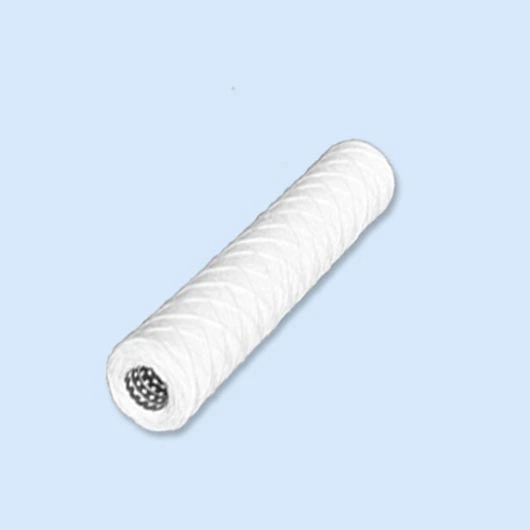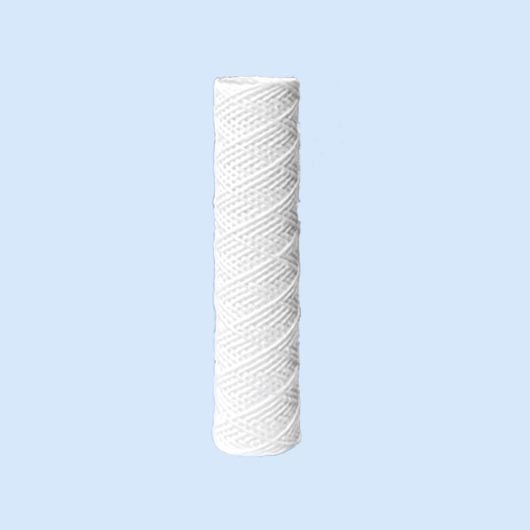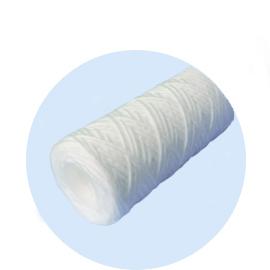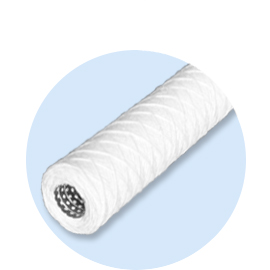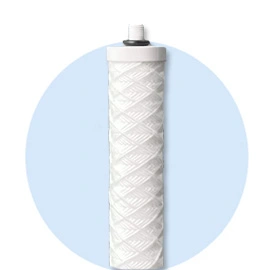

Cotton string wound filter cartridge
Cotton string wound filter cartridges with high temperature nature, the yarn is degreased cotton or bleached cotton, the inner core is stainless steel or tin plate, usually for hot water and food oil processing like palm oil, soy oil and vinegar, etc.
Inquire Now
Specification
STRUCTURE
String wound filter cartridge consists of multi-hole frames wound closely with textile fibers. Diverse kinds of filtering precision can be achieved by controlling the winding density. As the outer bore diameter is larger than the inner one, the filter cartridges have a good deep-level filtering capability. JP cotton series has straight multi-hole from surface to the inner core, which performance a maximum dirt holding capacity and lowest pressure drop. Because of its low impurity content and elevated temperature resistance, it's widely used in hot water filtration and food oil industries such as soy oil, palm oil vinegar filtration.
Available sizes: 2.5"x10", 2.5"x20", 2.5"x30", 2.5"x40".
Micron rates: 1micron, 5microns, 10microns, 25microns, 50microns, 100microns.
Yarn material: cotton
Inner core material: SUS304 stainless steel, 201 stainless steel.
FEATURES
• Through holes create real depth filtration
• Higherflow and lower pressure loss
• High dirt holding capacity and long service life.
• Cotton or polyester yarn and ss core which bare higher temperature
MAIN TECHICAL SPECIFICATION
• Dimension: Outer diameter Ø63±1mm Inner diameter Ø 28mm or Ø 30mm
• Maximum operating Pressure: 0.5MPa (72.5psi)
• Maximum operating Temperature: Cotton 150℃(302℉), PE 130℃(266℉)
TYPICAL APPLICATIONS
• Cooking oil, palm oil, soy sauce (cotton or PE)
• Organic solvents (cotton only)
• Petroleum product (cotton only)
• Other applications
TABLE 1
FLOW OF FILTER CARTRIDGE
The recommended flow for the filter cartridges in service is shown in the table (L/h for a 250㎜filter cartridge)
Note:
1. The flow of each 250mm(10inch)filter cartridge should not exceed 1200 L/H (317G/H), otherwise its precision may be affected.
2. The flows shown in the above table are only the recommended values. The actual flow of the filter cartridge in service may change due to the liquid nature, temperature, the nature of the eliminated particles, the contents of the particles, etc.
3. It is recommended that a new filter cartridge used in the first time should work under a pressure drop of 0.1 - 0.3 bar (1.45 – 4.35psi ), while the final pressure drop for the filter cartridge exchange is set at 2.5 bar. For the filter cartridge whose precision is lower than 10μm, the pressure drop for the filter cartridge exchange had better be set at 1.0 -1.5 bar (14.5 – 21.8psi).
TABLE 2
DIRT HOLDING CAPACITIES
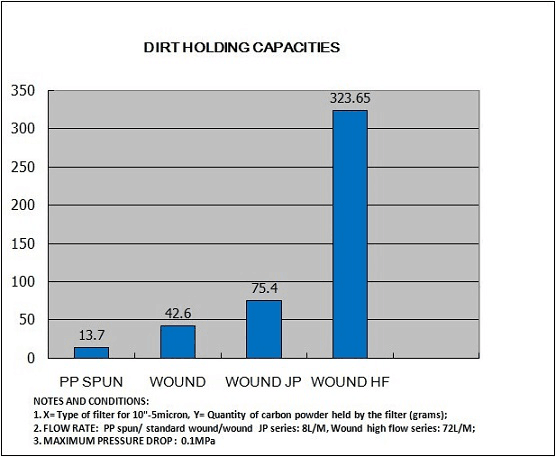
TABLE 3
ORDERING INFORMATION
SF W 20- 5 C 63 S 28 JP
A B C D
String wound filter cartridge consists of multi-hole frames wound closely with textile fibers. Diverse kinds of filtering precision can be achieved by controlling the winding density. As the outer bore diameter is larger than the inner one, the filter cartridges have a good deep-level filtering capability. JP cotton series has straight multi-hole from surface to the inner core, which performance a maximum dirt holding capacity and lowest pressure drop. Because of its low impurity content and elevated temperature resistance, it's widely used in hot water filtration and food oil industries such as soy oil, palm oil vinegar filtration.
Available sizes: 2.5"x10", 2.5"x20", 2.5"x30", 2.5"x40".
Micron rates: 1micron, 5microns, 10microns, 25microns, 50microns, 100microns.
Yarn material: cotton
Inner core material: SUS304 stainless steel, 201 stainless steel.
FEATURES
• Through holes create real depth filtration
• Higherflow and lower pressure loss
• High dirt holding capacity and long service life.
• Cotton or polyester yarn and ss core which bare higher temperature
MAIN TECHICAL SPECIFICATION
• Dimension: Outer diameter Ø63±1mm Inner diameter Ø 28mm or Ø 30mm
• Maximum operating Pressure: 0.5MPa (72.5psi)
• Maximum operating Temperature: Cotton 150℃(302℉), PE 130℃(266℉)
TYPICAL APPLICATIONS
• Cooking oil, palm oil, soy sauce (cotton or PE)
• Organic solvents (cotton only)
• Petroleum product (cotton only)
• Other applications
TABLE 1
FLOW OF FILTER CARTRIDGE
The recommended flow for the filter cartridges in service is shown in the table (L/h for a 250㎜filter cartridge)
| Micron Rate(μ m) | Viscosity | ||||
| 1cs(water) | 30cs | 60cs | 120cs | 250cs | |
| 0.5 | 70 | 60 | 40 | 25 | - |
| 1 | 150 | 90 | 60 | 40 | - |
| 3 | 300 | 120 | 80 | 50 | - |
| 5 | 500 | 170 | 120 | 60 | 45 |
| 10 | 800 | 300 | 140 | 70 | 60 |
| 20 | 1100 | 540 | 220 | 100 | 95 |
| 30 | 1200 | 670 | 300 | 150 | 130 |
| 50 | 1200 | 880 | 440 | 180 | 160 |
| 75 | 1200 | 1200 | 690 | 230 | 200 |
| 100 | 1200 | 1200 | 750 | 270 | 220 |
1. The flow of each 250mm(10inch)filter cartridge should not exceed 1200 L/H (317G/H), otherwise its precision may be affected.
2. The flows shown in the above table are only the recommended values. The actual flow of the filter cartridge in service may change due to the liquid nature, temperature, the nature of the eliminated particles, the contents of the particles, etc.
3. It is recommended that a new filter cartridge used in the first time should work under a pressure drop of 0.1 - 0.3 bar (1.45 – 4.35psi ), while the final pressure drop for the filter cartridge exchange is set at 2.5 bar. For the filter cartridge whose precision is lower than 10μm, the pressure drop for the filter cartridge exchange had better be set at 1.0 -1.5 bar (14.5 – 21.8psi).
TABLE 2
DIRT HOLDING CAPACITIES

TABLE 3
ORDERING INFORMATION
SF W 20- 5 C 63 S 28 JP
A B C D
| SF | Brand name |
| W | Filter type- W= string wound, PP= melt blown, PPL= PP pleated, CTO= carbon block |
| A | Length- 10/20/30/40, inches. 250/500/750/1000, mm. |
| B | Rating- 0.5/1/3/5/10/25/50/75/100/150/200 microns |
| C | Yarn material- P= polypropylene, C= cotton, E= polyester, GF= glass fiber, Z=Rayon |
| C | Outer diameter: 60/63/110/152 mm |
| S | Inner core material- P= polypropylene, S= stainless steel, SUS202 or SUS304 |
| D | Inner diameter- 28/30/70/100mm |
| JP | Series code- JP= JP series, HF= Hi Flow series |


